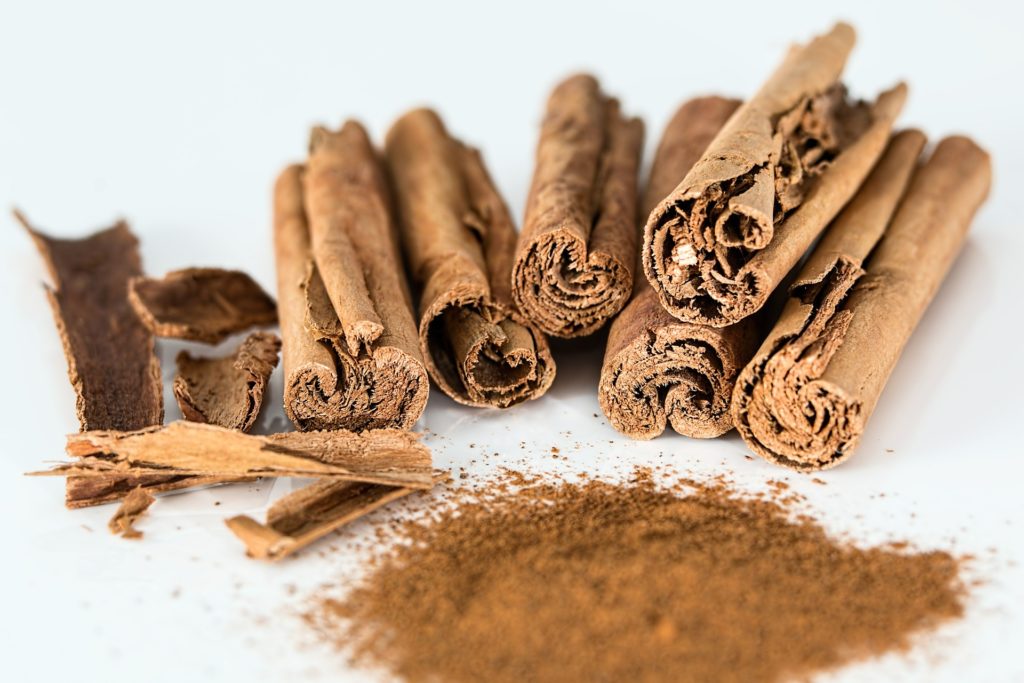Cinnamon

From cinnamon-stick ornaments, to gingerbread spices, cinnamon is a common herb encountered around the holidays. Yet unlike many other herbs that may be bitter or have an unpleasant flavor, cinnamon is often enjoyed in both savory dishes and sweet treats.
As an herb, cinnamon has been utilized in medicine for thousands of years. Historically, it was primarily used for digestive complaints among other concerns. More recently, cinnamon is being recognized for its anti-inflammatory, antioxidant, antimicrobial and blood sugar lowering potential along with other possible benefits.
Some of the latest research suggests that cinnamon:
- Lowers blood sugar
- Decreases inflammation
- Has potent antimicrobial effects
- Supports liver function (although with some caution around the type of cinnamon)
Cinnamon and Blood Sugar
Over the last twenty years, research has been expanding into the effects of cinnamon on blood sugar. An early trial found benefits for controlling blood sugar and for other health parameters in diabetics (Khan 2003). In the study, diabetics consumed either one, three or six grams of cinnamon daily. Overall, cinnamon consumption reduced:
- Blood sugar by 18-29%
- Triglycerides (a type of fat in the blood) by 23-30%
- LDL (or so-called “bad”) cholesterol by 7-27%
- Total cholesterol by 12-26%.
However, a trial in postmenopausal women found no benefits for blood sugar using just 1.5 grams of cinnamon per day (Vanschoonbeek 2006).
Further studies followed, with a water extract of cinnamon having modest benefits for lowering blood sugar in diabetics (Mang 2006). Overall, studies on cinnamon for blood sugar have been somewhat mixed. A review of all the research on cinnamon for blood sugar in diabetics concluded that cinnamon does lower blood sugar and insulin, but may not have effects on cholesterol. The authors noted a wide range of results and stated that a standardized product needs to be produced to better clarify cinnamon’s potential (Deyno 2019).
There could be multiple reasons for the somewhat varied results. Cinnamon is rich in essential oils, volatile compounds that can evaporate out of powdered material. There are also two different types of cinnamon with similar, but not identical constituents—more on that later. Extracts may also contain different amounts of active ingredients as compared to whole, powdered cinnamon.
Cinnamon and Inflammation
Cinnamon has been shown to have significant anti-inflammatory potential. In a study on women suffering with rheumatoid arthritis, cinnamon was shown to help. Rheumatoid arthritis can be a severe autoimmune condition that damages the joints, causing pain, swelling and discomfort. After two months of cinnamon supplementation, patients had lower levels of inflammation and decreased blood pressure. They also had reduced pain, swelling and joint tenderness (Shishehbor 2018).
Beyond human studies, animal research has also found benefits for inflammation and arthritis with cinnamon supplementation (Qadir 2018, Rathi 2013). Part of the anti-inflammatory benefits may come from the antioxidant potential of cinnamon. Inflammation often includes the production of free radicals, and cinnamon, especially the volatile oils it contains, are potent antioxidants (Zhao 2021).
Cinnamon as an Antimicrobial
Historically, cinnamon was used primarily for gastrointestinal concerns. This is likely due to the antimicrobial effects of cinnamon. Numerous studies have documented antibacterial effects against different bacterial strains, even strains resistant to standard antibiotics (Ginting 2021, Van 2021, Akrami 2021).
Beyond direct killing effects, cinnamon essential oils also have anti-biofilm potential. When threatened or when in more inhospitable conditions, bacteria can form biofilms, slime layers that contain bacteria embedded inside. Biofilms offer significant protection to the bacteria they contain and are the primary cause of chronic, antibiotic-resistant infections. As such, research has been steering towards strategies that can target biofilms directly to help clear them.
Essential oils have increasingly been explored for their novel antimicrobial effects, including against biofilms. Recent studies have found significant antibiofilm effects with cinnamon essential oil (Pourkhasravani 2021, Alibi 2020).
Cinnamon and the Liver

The liver is one of the most important organs in the human body. All the blood from the intestines is processed through the liver where it plays a role in digestion and metabolizing or breaking down chemicals and toxins. When the liver is inflamed, liver enzymes increase. A recent review of the research on cinnamon and liver function found that for patients with type 2 diabetes, cinnamon may help lower liver enzymes (Mousavi 2021).
However, concerns have been raised about one of the types of cinnamon and liver toxicity. Commercially available cinnamon comes in two types, Cinnamomum cassia and Cinnamomum verum. Cinnamomum cassia is often called “cassia” cinnamon, whereas Cinnamomum verum is often called “true” or “Ceylon cinnamon.” Cassia cinnamon contains a small but significant amount of coumarin, a liver toxic constituent. When isolated, coumarin is known to cause liver damage.
Possible Concerns with Cassia Cinnamon
As such, the European Union has set a safe level of consumption for coumarin, which can easily be exceeded when consuming cassia cinnamon. While—as far as I could find—there are no case reports of anyone ever developing liver toxicity from cinnamon used in food, there is one case report on liver toxicity from a cinnamon extract combined with a statin medication. Statin medications are known to have liver toxicity as a side effect. In the case report, the statin was restarted without the cinnamon extract and the liver toxicity did not recur (Brancheau 2015). However, a chemical analysis of the cinnamon extract was not performed. As such, the conclusion of the authors that the cinnamon was the definitive cause is still somewhat questionable. It’s also possible that there was a contaminant in the cinnamon supplement.
Even though the risks are likely very low, using true cinnamon is a simple way to eliminate concerns. True cinnamon is broadly available and both types of cinnamon appear to have similar benefits. Rather than have any concerns for liver issues, I typically just recommend using Cinnamomum verum or true cinnamon.
Conclusion
Cinnamon is a flavorful spice often used around the holidays. Some of the latest research suggests potential with cinnamon for helping to balance blood sugar, for decreasing inflammation and as a potential antimicrobial. Since the essential oil components in cinnamon are a large part of its potential benefits, using freshly ground cinnamon may be more effective than older powders. Considering how easy it is to add cinnamon to food, getting the benefits of cinnamon is often one of the easier suggestions that I give to my patients.



